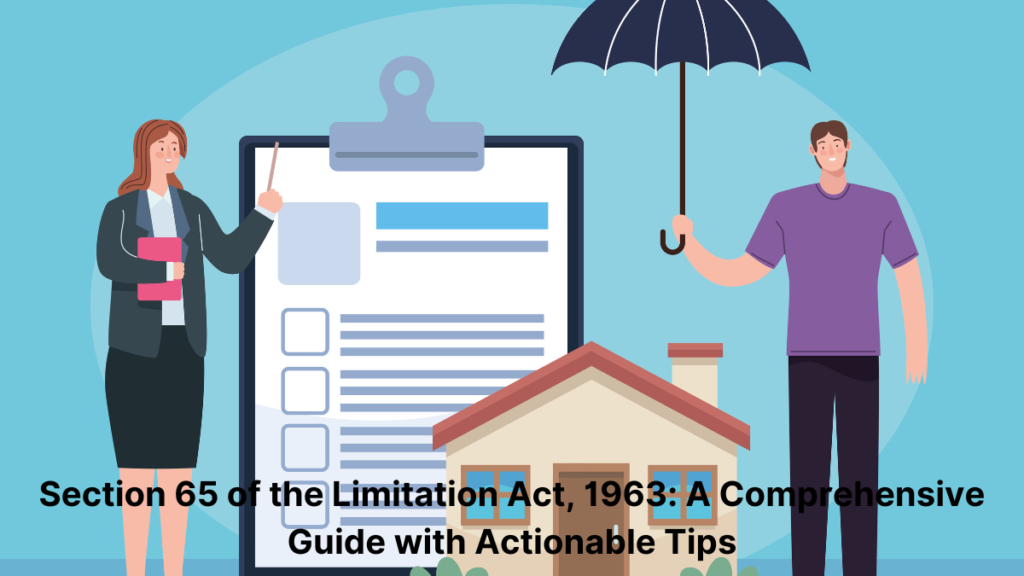Introduction
The Limitation Act, 1963, is a crucial piece of legislation that governs the time limits within which legal proceedings must be initiated. Section 65 of this Act plays a significant role in property-related disputes, particularly concerning adverse possession and prescribed limitations. Lawyers and advocates handling civil litigation must thoroughly understand how this provision applies in real-world cases.
This guide will break down Section 65 of the Limitation Act, 1963, provide real-life case examples, and show how Handyy Law Practice Management Software can assist legal professionals in efficiently handling such cases.
Understanding Section 65 of the Limitation Act, 1963
Section 65 states that a suit for possession of immovable property or any interest therein based on title must be filed within twelve years from the date the adverse possession starts. This section primarily concerns adverse possession claims, where an individual possesses property for a specific period and seeks legal recognition as the rightful owner.
Key Provisions of Section 65:
- Time Limit: A 12-year period applies from the time the possession becomes adverse to the true owner.
- Applicability: This section applies to disputes over property ownership and cases where a claimant asserts adverse possession.
- Exceptions: In cases where the rightful owner is a minor, mentally ill, or legally incapacitated, the limitation period may be extended.
- Burden of Proof: The person claiming adverse possession must prove continuous, uninterrupted, and hostile possession of the property.
How Advocates Should Approach Section 65 Cases
Lawyers handling property disputes under Section 65 should take a strategic approach:
- Conduct Thorough Case Research
- Review past legal documents and verify property ownership history.
- Gather supporting evidence like tax receipts, utility bills, and property records.
- Establish Key Legal Principles
- Analyze whether the client has legally valid adverse possession.
- Ensure that possession has been continuous, open, and against the interests of the true owner.
- Draft Strong Legal Notices
- Issue legal notices to establish formal communication regarding ownership disputes.
- Ensure notices align with judicial precedents.
- Use Precedents and Case Law
- Refer to Supreme Court and High Court rulings on adverse possession to strengthen arguments.
Real-Life Case Study: Adverse Possession and Section 65
Case Study Example:
Background: In a landmark case, Rajesh Kumar v. State of Karnataka (2021), the petitioner claimed ownership of a residential plot through adverse possession, arguing he had occupied it for 15 years and paid property taxes.
Court’s Observation:
- The court ruled that mere possession does not grant ownership unless it is hostile and against the true owner’s interest.
- The court upheld that adverse possession must be proven beyond doubt and must be peaceful, continuous, and known to the real owner.
Takeaway for Lawyers:
- Advocates handling adverse possession cases must collect substantial evidence proving hostile possession.
- Legal professionals must track time limits meticulously to ensure cases are filed within the prescribed limitation period.
How Handyy Law Practice Management Helps in Section 65 Cases
Managing property litigation cases effectively requires legal professionals to be organized and efficient. Handyy Law Practice Management Software simplifies the process by offering:
1. Case & Document Management
- Store, retrieve, and organize all case-related documents digitally.
- Maintain a clear timeline of property ownership records for quick access.
2. Legal Research & Citations
- Access an extensive online legal library for case laws related to Section 65 of the Limitation Act.
- Utilize AI-powered legal research tools to find relevant judgments in minutes.
3. Court Deadline Tracking
- Stay ahead of critical filing deadlines with automated calendar reminders.
- Avoid missing crucial time limits under Section 65 with timely alerts.
4. Drafting Legal Notices & Petitions
- Generate ready-to-use templates for legal notices and court petitions.
- Save time on drafting and improve efficiency.
5. Client Communication & Case Updates
- Share case updates with clients instantly through an integrated portal.
- Keep clients informed about their legal rights in property disputes.
Conclusion: Secure Legal Success with Handyy
Understanding and effectively handling cases under Section 65 of the Limitation Act, 1963, requires precision, expertise, and efficient case management. With Handyy Law Practice Management Software, advocates can seamlessly track cases, research legal precedents, and automate document drafting, allowing them to focus on winning cases instead of administrative tasks.
🔹 Ready to elevate your legal practice?
📌 Sign up for a 30-day free trial now!
👉 Click Here to Get Started

